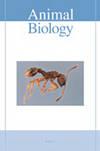Quality of deconserved bull sperm for the action of nanosuccinates Zn, Cu and Mn in the diluents
IF 0.9
4区 生物学
Q2 ZOOLOGY
引用次数: 3
Abstract
The purpose of this work was to compare effect of different doses of trace elements such as Cu2+, Zn2+ and Mn2+ that have been included as nano succinates into lactose-yolk-glycerol medium for cryopreservation of bull sperm and some physiological and biochemical sperm parameters assessment before and after cryopreservation. In this research each fresh ejaculate obtained from 4 bulls has been divided into parties consisting a control sample and its experimental counterparts. Control samples were diluted with industrial lactose-yolk-glycerin diluent only but their experimental counterparts were diluted and supplemented with nano acquacuccinates of Cu, Mn and Zn as solutions at concentration 2–5 g/l but different doses of 0.005, 0.01 and 0.05 mg/ml. When ejaculates were taken, the following physiological parametres of ejaculate quality were established: volume (ml), sperm concentration (billion/ml), live sperm count (%) and dynamic sperm count (CASA) and survival (h); content of total protein, respiratory activity of sperm, activity of enzyme markers of fertilizing ability — succinate dehydrogenase (SDH, units) and cytochrome oxidase (CHO, units) in diluted ejaculates with introduced minerals. After the ejaculates were diluted, semen was equilibrated for three hours at 4°C and frozen in a container (7 min over nitrogen vapor followed by immersion in liquid nitrogen). The semen was thawed in a water bath at 38°C for 20 seconds. The above physiological and biochemical parameters of the sperm of the bulls were redetermined immediately after thawing. Spermatozoa concentration in diluted bull sperm was 8.3% of the initial or ejaculate diluted 12-fold according to technological requirements (P<0.001). The number of live sperm decreased by 12.6% compared to fresh sperm (P<0.05), and the survival of sperm during incubation decreased by 6.8% for 7.4 hours. Total protein content in 100 ml of sperm decreased by 41.3% after dilution compared to fresh ejaculate (P<0.001). Respiratory activity decreased by 11.8% after the ejaculates was diluted. Succinate dehydrogenase activity decreased by 10.7% and cytochrome oxidase activity by 13.0%. In thawed bull sperm the respiratory sperm activity is higher in counterparts when 0.05 mg/l Zn2+, 0.05 mg/l Cu2+ and 0.05 mg/l Mn2+ are added to the medium. Enzyme activity at the same doses was higher. The highest activity among these groups of succinate dehydrogenase was at 0.05 mg/l Zn2+ (P<0.05) added to the cryopreservation medium, and the lowest at 0.01 mg/l Mn2+. Cytochrome oxidase activity was highest when 0.05 mg/l Cu2+ was added to the cryopreservation medium. The optimum concentrations of nanosuccinates that ensure the normalization of oxidation processes in the diluted bull sperm are: 0.05 mg/l Mn2+, 0.05 mg/l Cu2+ and 0.05 mg/l Zn2+. The higher concentration of metal nano succinates in the diluent inhibits the respiratory sperm activity and reduces the activity of succinate dehydrogenase and cytochrome oxidase. Similar effect has been estimated in dynamic performance of spermatozoa after thawing.稀释剂中纳米琥珀酸锌、铜和锰的作用对公牛精子保存质量的影响
本工作的目的是比较不同剂量的微量元素如Cu2+、Zn2+和Mn2+作为纳米琥珀酸盐加入乳糖-蛋黄-甘油培养基中对公牛精子冷冻保存的效果,以及冷冻保存前后精子的一些生理生化参数评估。在这项研究中,从4头公牛身上获得的每一份新鲜精液都被分为对照组和实验组。对照样品仅用工业乳糖蛋黄甘油稀释剂稀释,但用Cu、Mn和Zn的纳米acquaccinate溶液稀释并补充其实验样品,浓度为2-5 g/l,但不同剂量为0.005、0.01和0.05 mg/ml。采集精液时,建立了精液质量的以下生理参数:体积(ml)、精子浓度(十亿/ml)、活精子数(%)、动态精子数(CASA)和存活率(h);总蛋白含量、精子呼吸活性、受精能力酶标志物琥珀酸脱氢酶(SDH,单位)和细胞色素氧化酶(CHO,单位)的活性。精液稀释后,精液在4°C下平衡3小时,并在容器中冷冻(在氮气上冷冻7分钟,然后浸入液氮中)。精液在38°C的水浴中解冻20秒。解冻后立即重新测定公牛精子的上述生理生化参数。稀释公牛精子中的精子浓度为初始精子的8.3%或按技术要求稀释12倍的精液(P<0.001),活精子数量比新鲜精子减少12.6%(P<0.05),孵化7.4小时后精子存活率下降6.8%。与新鲜精液相比,稀释后100 ml精子中的总蛋白质含量下降了41.3%(P<0.001),呼吸活性下降了11.8%。琥珀酸脱氢酶活性下降10.7%,细胞色素氧化酶活性下降13.0%。在解冻的公牛精子中,当向培养基中加入0.05mg/l Zn2+、0.05mg/l Cu2+和0.05mg/l Mn2+时,呼吸精子活性较高。相同剂量的酶活性较高。在这些组中,琥珀酸脱氢酶的活性最高的是添加到冷冻保存培养基中的0.05mg/l Zn2+(P<0.05),而最低的是0.01mg/l Mn2+。当向冷冻保存培养基中加入0.05mg/l的Cu2+时,细胞色素氧化酶活性最高。确保稀释公牛精子中氧化过程正常化的纳米琥珀酸盐的最佳浓度为:0.05 mg/l Mn2+、0.05 mg/l Cu2+和0.05 mg/l Zn2+。稀释剂中较高浓度的金属纳米琥珀酸盐抑制呼吸精子活性,降低琥珀酸脱氢酶和细胞色素氧化酶的活性。在精子解冻后的动态性能方面也有类似的效果。
本文章由计算机程序翻译,如有差异,请以英文原文为准。
求助全文
约1分钟内获得全文
求助全文
来源期刊

Animal Biology
生物-动物学
CiteScore
2.10
自引率
0.00%
发文量
34
审稿时长
3 months
期刊介绍:
Animal Biology publishes high quality papers and focuses on integration of the various disciplines within the broad field of zoology. These disciplines include behaviour, developmental biology, ecology, endocrinology, evolutionary biology, genomics, morphology, neurobiology, physiology, systematics and theoretical biology. Purely descriptive papers will not be considered for publication.
Animal Biology is the official journal of the Royal Dutch Zoological Society since its foundation in 1872. The journal was initially called Archives Néerlandaises de Zoologie, which was changed in 1952 to Netherlands Journal of Zoology, the current name was established in 2003.
 求助内容:
求助内容: 应助结果提醒方式:
应助结果提醒方式:


